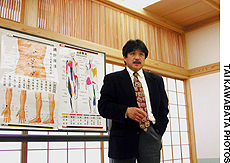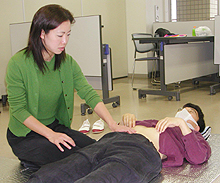WEEK
3
KINSINDAN
A hands-on approach to healing in a
trice
By TAI KAWABATA
Staff
writer
Lying on your back, you pull up your
shirt and push down your pants a bit. Your partner gently
touches your navel, then moves their fingers slightly down.
 |
| Satoshi Kono
|
No! No! No! It's not what you think!
Yes, your partner may be a member of the opposite sex --
but their fingers never descend more than three finger-widths
from your navel. And their countenance is nothing if not
serious.
What's happening here is a practical class for students of
a form of medicine called kinsindan (literally, "muscle
diagnosis"), which is claimed to have almost magical healing
powers for certain health problems.
 |
| One student practices detecting
another's hardened muscles at a Tokyo kinsindan class
run by Satoshi Kono. |
Just listen to 50-year-old acupuncturist Satoshi Kono, one
of Japan's 20 to 30 practitioners, for instance. Kono, who
teaches kinsindan in Omori, in Tokyo's Ota Ward -- where he
also has his clinic -- recounts the tale of a lady of about 70
who had compression fractures of the vertebrae and hip bones.
"She could hardly walk," Kono explained. "And she could not
even put on socks by herself.
"But then, after doing a kinsindan diagnosis, I pasted a
tiny triangular piece of yellow paper on a treatment point on
her left leg, and another white piece on her right hand."
You guessed: Eureka!
According to Kono, the old lady promptly stood up and
nimbly began walking without any difficulty. And let's not
forget those socks. Thereafter, she could don them all by
herself.
"The treatment -- just consisting of pasting tiny pieces of
colored paper on the body -- made the movement of the lady's
joints and muscles smooth, enabling her to walk," Kono
declared.
Two months off workIn another case, a 38-year-old man
was hardly able to write or type due to pain in his right arm,
and had been off work for two months as a result. However,
after Kono pasted a piece of white paper on his left hand and
a piece of black paper on his right foot, he immediately
became able to write without any pain or difficulty. To
stabilize the effect, Kono applied acupunture to the man's
torso, and the next day, he went back to work and has not
reported any return of the symptons since. The man paid 7,000
yen for the treatment.
But is this exclusively Japanese practice mere
superstitious hokum?
Certainly not, according to Kono, whose father Tadao, 84,
an acupuncturist from Hamada, Shimane Prefecture, developed
kinsindan in the 1970s, and publicized it in a 1986 book
titled "Kinsindan Ho (Kinsindan Diagnosis Method)."
Tadao Kono used to practice the Hashimoto Method of
bloodstream diagnosis to treat his patients, Kono explained.
That method developed by Masae Hashimoto before World War II
involves feeling along arteries to sense not only the pulse
but also the blood flow and many other aspects of a body's
condition.
However, because that diagnostic technique was so highly
skilled, Kono said, that his father sought a more
straightforward method to hand down to younger generations.
This he found after becoming acquainted with Applied
Kinesiology, which was developed in the 1960s by George
Goodheart, a Detroit chiropractor.
Goodheart propounded the theory, and practiced on the basis
that each internal organ is connected with a muscle or group
of muscles, and that problems with an organ manfiest
themselves in a weakening of that muscle or those muscles.
Hence AK treats the afflicted organ by restoring power to the
related muscle or muscles.
Kono explained that his father found he could diagnose
organic problems by detecting a hardening of the related
muscle or muscles. So, in kinsindan, organs are treated by
measures that relax the related muscle or muscles.
And the form this treatment takes is (don't laugh) simply
tying colored string round the wrist or ankle or applying
triangular pieces of colored paper to the appropriate points.
Kono, who studied kinsindan under his father after
graduating from acupuncture school, explains: "The hypothesis
is that the skin can recognize a color and that the skin is an
eye. The color serves not as a stimulus but as information. By
receiving the information, the body's inherent mechanism to
automatically restore itself to optimum balance kicks in.
"But the outstanding thing about kinsindan is that if a
color is applied to a correct treatment point, the effect
appears instantly. Just one or two colors will do. Three
colors at most."
In fact, the six colors used in kinsindan are white,
yellow, red, black, pink and blue -- each corresponding to a
certain "system" in the body.
Treatment of course starts with diagnosis -- which involves
touching various precisely defined points around the navel and
abdomen. If hardness is found, so kinsindan theory dictates,
the system related to that point -- be it the spleen, lungs,
liver, heart, kidneys or whatever -- is ailing.
However, if several hardnesses are found, to determine the
prime problem zone, practitioners unveil their secret weapon:
a pencil-like stick with the North pole of a magnet protruding
from one end. This they apply to all the hardened diagnosis
points until they find the one on which contact with the
magnet relaxes all the related muscles -- so indicating the
prime clinical culprit.
After an appropriately colored paper triangle is applied to
the corresponding treatment point, treatment is then over.
If you, skeptical reader, are tempted to titter, then Kono
says all you have to do is test kinsindan for yourself.
To really bowl yourself over, he says, just try touching
your toes without bending your knees and see how far you get.
Then tie a black string around the right wrist if you are a
woman, or the left if you are a man, and try touching your
toes again. Eureka! Just see what happens.
"My hope is that many people learn the kinsindan technique
and become like barefoot doctors who can help family members
and friends and reduce dependency on hospitals," Kono said.
But if you've got flu, he added, then go and see a
physician.
The Japan Times: May 15, 2005
(C)
All rights reserved |